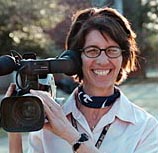Wednesday, May 8: Bring-ring-ring, chirps my cell phone. Is it good news, or money? It is bad news, and money. A fire set by the National Park Service is out of control in Los Alamos, New Mexico. The town is being evacuated - can I head up there for ABC News? I am in the southern part of the state, way out of position, on the road. I need a pit stop for a flat tire in Roswell, and another pit stop at home to pick up boots. When you walk into a wildfire area, the ground underfoot will melt sneakers. I phone the first two ABC crews who are already at an overlook in Los Alamos. I suggest that one crew hold the position, and the other take a look at the town of White Rock, where a shelter is being set up. More ABC producers arrive in New Mexico from LA. They take in feeds at KOAT, our affiliate in Albuquerque, and cut them for the network. I finally arrive at our feed point in Los Alamos. I need to book a guest for a morning live shot. I book Gary Johnson, the governor of New Mexico, to be our guest. Good Morning America also wants a firefighter, so I find a firefighter, too. I break one crew for sleep; the other goes to shoot more video in the town of Espanola. By 2AM I learn that our satellite truck has been stopped at a police roadblock, and will not be allowed into Los Alamos. I ask KOAT for help, and they agree to do the shot from their microwave truck. The microwave will send a signal to KOAT, which will microwave to KNME, the public TV station in Albuquerque, which will uplink to a communications satellite. There is a problem involving satellite time, at ABC and CNN, that gets worked out in New York and Washington. At 5AM we do our live shots. Afterward I want sleep. The Los Alamos Inn is in the evacuated area, but it is open to accommodate firefighters and media. When I check in to the hotel, the clerk asks me if I want a room that is "smoking, or non-smoking?" What, are you kidding, the entire town is smoking. I sleep for an hour or two. Now ABC News has one satellite truck, six producers, five camera crews, two editors, and two correspondents assigned to the Los Alamos fires. We are lodged in two hotels and work in an RV, plus a workspace room in the Los Alamos Inn. In addition, there is a reporter, camera crew, and satellite truck dedicated to providing live shots and feeds to ABC affiliate stations. KOAT is on the air with wall-to-wall coverage.
They are assisted by crews from sister stations around the country. The
fire burns out of control, threatening Los Alamos National Laboratories,
and consuming over two hundred homes.
Thursday, the hotel gives a key to my room to a firefighter who needs some sleep. I will never see the exhausted unknown soul. He will be back out on the fire line before I crash for a few before my next a.m. live shot. The moon is orange. Some of the sunsets are scarlet, others are brown. On the weekend, one more producer is hired to take in feeds at KOAT, and three more producers arrive to book guests and manage live shots for Good Morning America. One Denver crew rotates out, to cover the release of the Columbine report, and another returns to Dallas. One freelance crew is released, but is picked up by another client and stays at the fires. Sunday is Mother's Day. Jon Leiberman, a KOAT reporter covering the story for the duration, reminds his team to call Mom. The network crews resign themselves to blowing another holiday. First I missed our anniversary, they say. Now Mother's Day. Godiva Online saves the day, for some. I call my mother. My kids call me. They are concerned about my safety. I am not needed on the fire line, nor in the air. On Tuesday it's cameraman Dale Greene's birthday. He shoots the EPA mobile radiation lab trailer, the Red Cross efforts at Pojoaque High School, and some slurry planes. He works with his wife Cindy Barchus, who does audio. The Greene crew and I have spent a number of holidays and birthdays together. There are no stores open in Los Alamos, except the Conoco Station. Ralph Binder, a cameraman from Denver, arrives at Dale's birthday celebration with some gifts from the gas station, wrapped in newspaper. Plastic toys and vampire teeth, a collector's set of whiskeys, a chewing gum cigar. I am so touched by Ralph's gesture that I am almost willing to forgive him for playing an annoying tape of something called The Llama Song every time I ride in his Suburban. I don't go to that many big stories. Those who report all the big stories have no stomach for covering victims of tragedies. They're tired of the overkill. One uplinker asks a camera crew, "Have you covered any school shootings? When did they turn on you?" They concur that a pattern develops. The first couple of days, people come over to the camera, because they have something they want to say on television. Later, the same people are outraged that the same camera is there. Victim behavior, along with media behavior, is an American subculture. When the residents of the destroyed homes are allowed to view the wreckage, the police and National Guard allow one camera crew on the scene. They pool their footage with the rest of us. Four hundred people from Los Alamos lost their homes. This means less to our viewers than a close look at one person or family. I talk to residents fresh from seeing the ash pile. They were transported in on a school bus and they're at the Los Alamos Inn for a rest stop. I ask some of them whether they would like to talk about it, on tv. Some say yes. Each person who agrees to an interview is approached by another network for another interview, and another, and another. I tell Ralph that if I find someone who wants to talk to us, I'll call him on the cell phone and we'll go out a different exit. I talk to a woman and her daughters leaving the ladies room. She doesn't want to give an interview. The newspuke in me yields to my desire to help. She asks me how to get in touch with FEMA. I give her the 800 number and the names and cell phone numbers of some FEMA representatives. I abandon my exit plan. We have home video from the boyfriend of one of the victims. The victim and her roommate agree to be live guests, via satellite, on Good Morning America. At 4:30AM the next morning, I visit the live shot set-up. I am assigned to a different live shot with correspondent Mike Von Fremd, for 6 AM. I chat a bit with the two guests. They joke about the men, many of them engineers or nuclear physicists, in Los Alamos: The odds are good, but the goods are odd. Tuesday evening, one of my children performs in a school concert. I drive home to attend. She's great. It's the best day of my life. Late Tuesday night I go to KOAT to dub some file footage from Los Alamos Lab. Wednesday morning I'm back in the smoke. Thursday it's beginning to clear. The Forest Service says that the fire will smolder until the summer rains put it out. But it is nearly contained. Thursday afternoon, Interior Secretary Bruce Babbitt makes his preliminary report in Santa Fe. He is a live guest Friday for Good Morning America. The network regulars move on to the next assignment. I have a couple of day jobs in Albuquerque. Then I resume being Mom. I don't have to tell a radio audience that I am my kidsí Mom. I don't have to celebrate Mother's Day. I do my work, and I go home. I don't need to report on tragedy to know how fortunate I am. I already know. |

